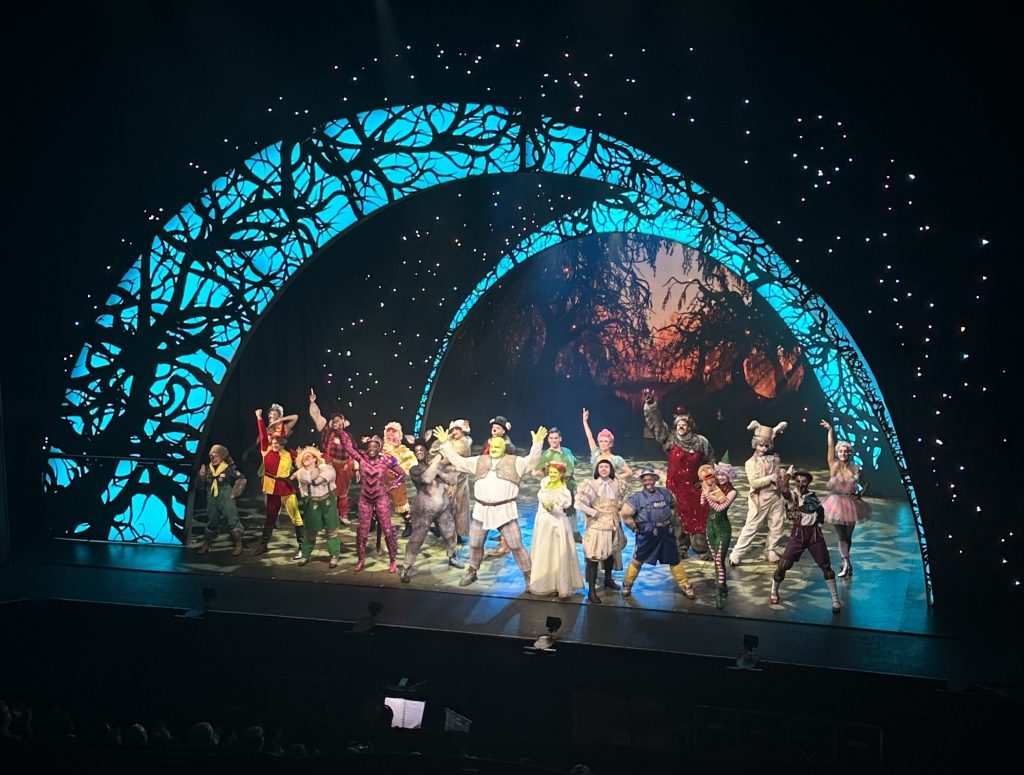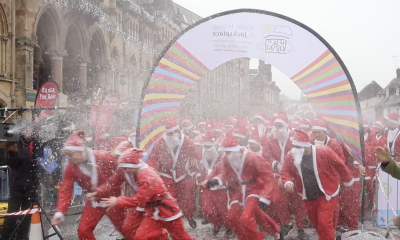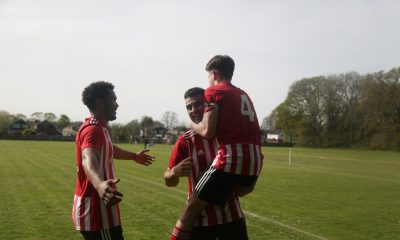Culture
REVIEW: Shrek The Musical at Mayflower Theatre

Shrek has come from Far Far Away and transformed Mayflower Theatre to one of the most glamorous swamps that I’ve ever seen! Yes it really is the same Shrek we all know and love but this time he’s on stage starring in his very own musical, ’Shrek The Musical’. The fairytale story of Shrek is one that everybody knows. Mike Myers’ iconic character is somewhat of a cult classic, with the 2001 hit film (and film series) being the cinematic universe for all things fairytale. This is a direct retelling of the story from the first film but all retold through an original script and soundtrack by David Lindsay-Abaire and Jeanine Tesori. ‘Shrek’ is a musical that has thrived at the heights of Broadway and The West End, and I was lucky enough to see that same award winning show on its first UK tour back in 2015. This version of the musical is a brand new production from directors Samuel Holmes and Nick Winston, being designed by Philip Witcomb. So having seen the original production, I was extremely excited to see how it had changed!
One of my initial thoughts of the show was, “Where has half of this show gone?”. This isn’t in terms of story, the same brilliant story and soundtrack is there, but rather in terms of the actual production value. With this being a big Broadway production, officially licensed by Dreamworks, you would be expecting to be fully transported into this fairytale world through the set, the design, and the theatre magic.
It is good fun for all ages of the family – especially if you are fans of Shrek.
Unfortunately, this just didn’t quite happen for me compared to how the original show looked. ‘Shrek’ is another touring musical that has yet again opted out of the major physical set option, but instead opted for projection effects that just aren’t quite up to standard. There were certain little details that were missing, and they felt as if they were missing as well (more on this later). This is all of course in comparison of what the show used to be, so if you have yet to see the show – that sense of magic will no doubt be there. Combined with the music and upbeat cast, some of the effects do work really well and it is good fun for all ages of the family – especially if you are fans of Shrek. However, having seen what the production has been previously and what it could have been, it’s confusing as to why it has changed so much.
This isn’t to take anything away from the cast however. The cast was big and they were great. Playing the roles of ‘Shrek’ and ‘Princess Fiona’ were the extremely talented Antony Lawrence and Joanne Clifton, who shared a fantastic love and comedy bond on stage. The role of Eddie Murphy’s ‘Donkey’ was perfectly portrayed by Brandon Lee Sears, again sharing a great comedic partnership with Antony – firing both physical gags and spoken jokes for children, and some more crude for the adults. Talking of crude jokes, James Gillan played the role of ‘Lord Farqaad’, in a camped up reversion of the character – getting plenty of laughs every time he appeared on stage.
Her voice was absolutely incredible.
I particularly liked his little nod to ‘Defying Gravity’! I’d also just like to give a shoutout to two performances in particular that I believe stole the show. Cherece Richards, who played the role of ‘Dragon/Wicked Witch’ was incredible as the Dragon. Her voice was so powerful and beautiful, she literally owned the stage whenever she was singing. The other stand out performance had to be that of Georgie Buckland playing the roles of ‘Gingy/Elf/Bluebird/Dragon Puppeteer’. Her interpretation of ‘Gingy’ sounded like it was straight out of the movies (yes she said “Do you know the muffin man” & “Not my gumdrop buttons” and it was a magical moment!), and then when she started singing as well… WOW! To be dancing, whilst sounding like a well known character, whilst singing, and controlling a puppet. Phenomenal! Her voice was absolutely incredible, what a gift!

In terms of set and lighting, as I’ve already mentioned it seemed to be a little bit lacklustre. From seeing what it was to what it is now, there was so much potential that just seemed to be lost. The lights were actually very impressive, big and on brand, with clever use of spotlights and shadows at points as well. The set used lots of projections. There were large moments when only a curtain with moving projections was used, leaving two thirds of the stage unused and it became quite boring to look at. Certain bits of set did seem to be missing as well.
The use of puppetry was very effective and I do have to say I really like the way in which the ‘Dragon’ was done, and love the way in which ‘Gingy’ was done. But again, having seen how the Dragon was portrayed previously, this just doesn’t came anywhere close. The effects were much the same. The ‘death’ of ‘Lord Farqaad’ was uninspiring. A half finished projection, with some haze and a flash of lights doesn’t present any theatre magic towards creating a sense of danger or fear. You may remember a scene from the film where ‘Princess Fiona’ makes a bird explode from singing. This moment again had so much potential but ended up with a puppet being thrown off of the stage. Having said this however, the mixture of the lights with the puppetry and projection effects was at times very effective in creating suspense and a scene. You would definitely feel as if you were part of a fairytale land, just maybe not as much as if it was physical set pieces instead.
It was almost like I was waiting for things to happen, and then they never did.
The original soundtrack is one that is quite well known by now; with songs such as ‘I’m a Believer’, ‘Big Bright Beautiful World’, and ‘I Know It’s Today’. Having a live orchestra for this was really nice! During ‘I Know It’s Today’, I did notice a lot of people in the audience seeming quite confused at exactly what was going on. Originally, this song is sung by a child, teen, and adult version of ‘Princess Fiona’. However, in this version it is just three adult Fiona’s all of different height and it was hard to differentiate between. A big change from the original was also not seeing ‘Lord Farqaad’ on his knees all show (If you know, you know). I actually quite liked seeing so much movement from Farqaad, but am not sure if this took away from the comedic value of him being so short or not. For me it just seemed to be the little details that were missing that really made this show the last time around. For example Pinocchio’s nose not growing made an entire piece of dialogue really confusing for me, and its another piece of theatre magic that’s just lost. It was almost like I was waiting for things to happen, and then they never did.
I know that I have been drilling and thinking into this far too much. ‘Shrek’ is a lighthearted and fun story, retold on stage for all of the family. And does it do that? Yes it absolutely does! I think it is unfair to fully focus on a comparison of what the show used to be because if you hadn’t seen the original, I believe you could still be blown away by some of the effects and theming used. This was never intended to be a groundbreaking piece of theatre, but it easily could have been. The scripting is funny and very clever, with some fantastic nods to popular culture and links back to the movies. The soundtrack is also brilliant, and being performed live is exactly what musical theatre is. To sum up, this is definitely a great show that’s lots of fun, but I wish people could also have seen how it was originally portrayed! This new production was pantomime-esc but whether the show has cut so much to commercialise or not, you can’t take too much away from how it was performed. It’s still a great bit of family fun and a must see for all Shrek fans – a packed Mayflower Theatre on a Tuesday night tells you all you need to know! ‘Shrek The Musical’ is touring until May 2024 before heading to London’s Hammersmith Apollo in July and I wish all of the cast, crew and company the best of luck going forward.
Culture
Where confidence takes centre stage: How theatre transforms

Performing arts education isn’t just about learning to act, dance, or sing – it’s vital in developing many young people’s confidence and self-expression.
In a digital age where young people are spending more time on their devices than ever before, theatre education provides lifelong skills like communication, resilience and teamwork.
I caught up with some of the students at Artisan Theatre School, a Hampshire based youth theatre club, to see if this rings true.
Ben, 18, said his time at theatre school has “helped develop people skills” and made him “a more confident person”.
He urged other young people to “get involved and enjoy it!”
Daniel, 17, shared a similar sentiment saying his “confidence has grown a lot”.
Theatre education can open a whole world of new opportunities for young people, giving them the space to discover their talents and explore future career paths.
Lucy, 17, has attended Artisan Theatre School for nine years and said: “I want to be a performer in some capacity.”
She added: “That’s my dream because of Artisan.”
Emma, a singing teacher at the school, said performing arts education is “beneficial to anyone,” not just those pursuing it professionally.
She added it can be especially valuable for children with SEN, helping them build confidence, improve communication, and “come out of their shell” in a supportive environment.
Unfortunately, despite its benefits, arts education is not guaranteed for every young person.
Cuts to funding over the last decade has had a significant impact, limiting access to creative learning opportunities.
The Cultural Learning Alliance’s 2025 report reveals a 42% decrease in Creative Arts based GCSE entries since 2010, and a 27% decline in the number of Arts teachers.
Sam Blackwell, principal and founder of Artisan Theatre School, said arts education is “really important” and that “they don’t do enough of it in schools”.
She explained that her vision in creating the school was to “give back more to kids and get them being confident”.
To help fill the gaps left by reduced arts provision in schools, Sam plans to introduce additional classes and offer increased opportunities for her students to learn from industry professionals.
Culture
And we all keep dancing for it can’t get any worse (90s/00s)

The Shakespearean nature of Tony Blair’s time as Prime Minister is something that had never been seen and his obsession with “the spin” that had won him the 1997 election and made him one of the most popular prime ministers when entering office.
With large proportions of the public optimistic for his premiership incoming.
A fall from grace would ensue much like Macbeth.
It would be cruel and untrue to reflect on Tony Blair’s premiership to say that it was a complete failure, especially as many still see him as one of the best PMs the UK has ever had.
Since one of the biggest landslides in UK election history in 1997, he was able to push through many socialist policies without much of a hassle: inflation was low, crime was down by a third, children were achieving some of their highest results ever in school, thousands more students were going to university, a million pensioners and three million children had been taken out of poverty, the quality of the air, beaches, and drinking water was as clean as before the industrial revolution.
However 9/11 changed everything. The era of youthful optimism and rebellion has been replaced by what a lot of thinkers call post-post modernism.
At site Zero, George Bush claimed that “those who are responsible must be brought to justice.”
He outlined Cuba, Iran, Libya, Syria, North Korea and most importantly Iraq.
Once the troops stepped into Iraq, it was the start of a domino effect that quickly decimated Blair’s time as PM.
Unlike Kosovo and Sierra Leone, Britain’s involvement in Iraq did not have the public’s support.
In his book The Prime Ministers, Steve Richards remarks that Tony Blair had not assumed any cabinet position in the lead up to his premiership and asks:”What if Blair had been foreign secretary? at least he would’ve seen, and interpreted intelligence – an explosively contentious issue in the run-up to the Iraq War.”
And then, the day after London had been announced as the host of the 2012 Olympics, on the 6th of July 2005, 7/7 happened.
Four terrorists detonated bombs on public transport – 52 killed and 784 were injured.
When times get tougher and life gets sadder, what do people do? Dance to forget
Prince William and Kate were leaving a Chelsea nightclub at 3am, Prince Harry was partying with Kanye West and getting into a scuffle with photographers at 4am.
The 2000s club scene was here and everyone was taking part; it was loud, it was abrasive, and it was here to stay.
Since the introduction of the stifling 1994 Criminal Justice Act, which is considered to have brought the illegal rave era largely to a close, “free parties” were the new get-around of the law: Student clubs offering “buy one, get three free” on alcopops and 50p doubles for an hour.
Halls bars were £1.20 a pint. Artists like LCD Soundsystem, Missy Elliot and Rihanna began their rise to fame with dirty, booming soundscapes that captured the drug-fuelled atmosphere of clubs as everyone dances to a beat that never seems to end, drenched in sweat.
Films like Trainspotting capture the allure of 2000s clubbing but the grim reality, drugs have found their way into the club scene.
Much like the Oasis album Standing on the Shoulder of Giants is described as Oasis’ “come down album”, the 2000s was a comedown era of clubbing.
The times were sad, but the music got louder?
As David Cameron’s government entered Number 10 Downing Street in 2010 and ushered in 14 years of austerity, where exactly would clubbing culture go with almost all clubs closing….
Culture
REVIEW: Sigrid – There’s Always More That I Could Say

2 out of 5 stars
A disappointing third album filled with negativity
In all honesty, I was late to Sigrid’s party.
I started following the Norwegian pop star in 2023 when she had already released two albums and completed a slew of EPs and international tours.
In no time at all, I was captivated by her rasping tones, funky rhythms, and cool electronic synths.
When news broke that her third album would be releasing on 24 October, it was no surprise to find myself listening and assessing it…
Jellyfish is the first single and the most lighthearted. I like it.
It’s a nice story about two people meeting at a dance and kindling a relationship.
Sigrid sings in a syncopated rhythm, giving a jazzy tone to the tune.
For the first time in her career, she includes a flute.
Cold, gritty, grim
It plays a flourish at the beginning but I can’t hear it throughout the rest of the track. It would be good to hear more of the flute in future.
Fort Knox is single number two. As the name suggests, this is a cold, gritty, grim song about a woman betrayed by her man.
This betrayal cuts so deep that she has retreated into her shell to “lock my love up in… Fort Knox”.
I enjoyed the dramatic, dark nature here, especially the war cry chorus throughout the song.
Towards the end, you would think the song has finished before it plays one more crescendo of strings to cap things off. I thought that was unnecessary.
The third single, Two Years, is written from the perspective of the woman’s boyfriend, another new departure for Sigrid.
He has been chasing for that exact period of time. It’s a cheery song with a strong beat, despite the desperate lyrics like: “What are you running from? / Why did you let me go?”
I’ll Always Be Your Girl is another sad song of frustration and heartache caused by a rowdy, hot-headed partner.
It is sung very well, especially the pleading chorus line, and the drum-guitar combination gives me something to nod along to.
Unconventional energy
Do It Again is the most unremarkable song on the album.
There is a good guitar and drum track, however the story again is quite predictable for Sigrid (being tempted to rekindle on old flame relationship).
Kiss The Sky returns to more unconventional energy which is great.
A lovely fade into the track leads into the main verses.
This time, Sigrid is speaking her verses with a distorted effect rather than singing them. It sounds good and complements her natural raspiness.
A strong guitar riff carries us through the bridge. The electronic synths make this seem like a 1980s dance track.
It’s only the lyrics that make this song a story of disappointment between lovers.
There is sexual innuendo in Hush, Baby, Hurry Slowly.
You could interpret it as a man and woman deciding whether to move forward with their relationship.
You could see it as partners deciding whether to have sex or not.
As a result, it’s an interesting song and makes you listen to try and work it out.
The structure shakes things up by starting with the chorus fading in.
The song ends with the melody slowing down and lowering in pitch, reflecting the title in musical terms.
The title track is the obligatory solo piano song.
Sigrid has had at least one piano focused song in all albums.
This is the most beautiful song in the album, featuring solo piano and a nice resonance on the voice.
The lyrics still contain tensions between people, like “giving…my worst” as a girlfriend.
Nevertheless, this is my favourite song from this year’s collection.
The penultimate track is also the longest in the album.
Have You Heard This Song Before picks up the energy from the previous song with a predictable but welcome mix of drums and synths.
The lyrics are pretty hopeful in tone about wanting to spend time with your partner. This is the most positive track on the album.
The last song, Eternal Sunshine, is a conventional finale song.
It has a regular beat and instrumentation.
It is another song built out of frustration with a partner – she wants to “drink” him out of her mind.
It would have been nice to have something different to end on – maybe a different topic.
This is the shortest album Sigrid has released. That is disappointing.
There are 10 songs in only 31 minutes.
I would have expected the usual 12 tracks or more.
The previous albums managed it fine.
Sucker Punch (2019) and How To Let Go (2022) contained 12 songs. The Special Edition of How To Let Go added 15 songs on top of the originals.
This album differs from the last two in that every song but one is constantly loud, energetic, and pumping.
I would have preferred more balance between softer and pounding songs.
How To Let Go had more positivity in it, such as singing in a taxi, body-confidence in the mirror and making the most of life.
This album has replaced that with disappointment and frustration.
It is the album with the most “explicit” songs – never before have we had an album with so much swearing.
I hope that is toned down in future.
Here’s hoping that the next album is more positive, unconventional and creative.
Perhaps that will come out in three years, like the others.
There’s always more that Sigrid could say (sorry, that was a terrible joke).
-

 Winchester News Online2 years ago
Winchester News Online2 years agoWinchester M3 Junction 9 hit with environmental concerns
-

 News2 years ago
News2 years agoFestive Santa Fun Run is here again!
-

 Culture2 years ago
Culture2 years agoREVIEW: Oh What A Lovely War at MAST Mayflower Studios
-

 Sport2 years ago
Sport2 years agoColden Common come back from two goals down to hammer Paulsgrove
-

 Sport1 year ago
Sport1 year agoSaints Legends fall to penalty shootout defeat
-

 Winchester News Online12 months ago
Winchester News Online12 months agoUoW Futsal 2nds claim their first ever win over their senior Winchester rivals
-

 Winchester News Online11 months ago
Winchester News Online11 months agoFeeling down in winter is often regarded as winter blues, it may however be something a lot more serious
-

 Winchester News Online1 month ago
Winchester News Online1 month agoGreenham Common holds half marathon in aid of baby charity
